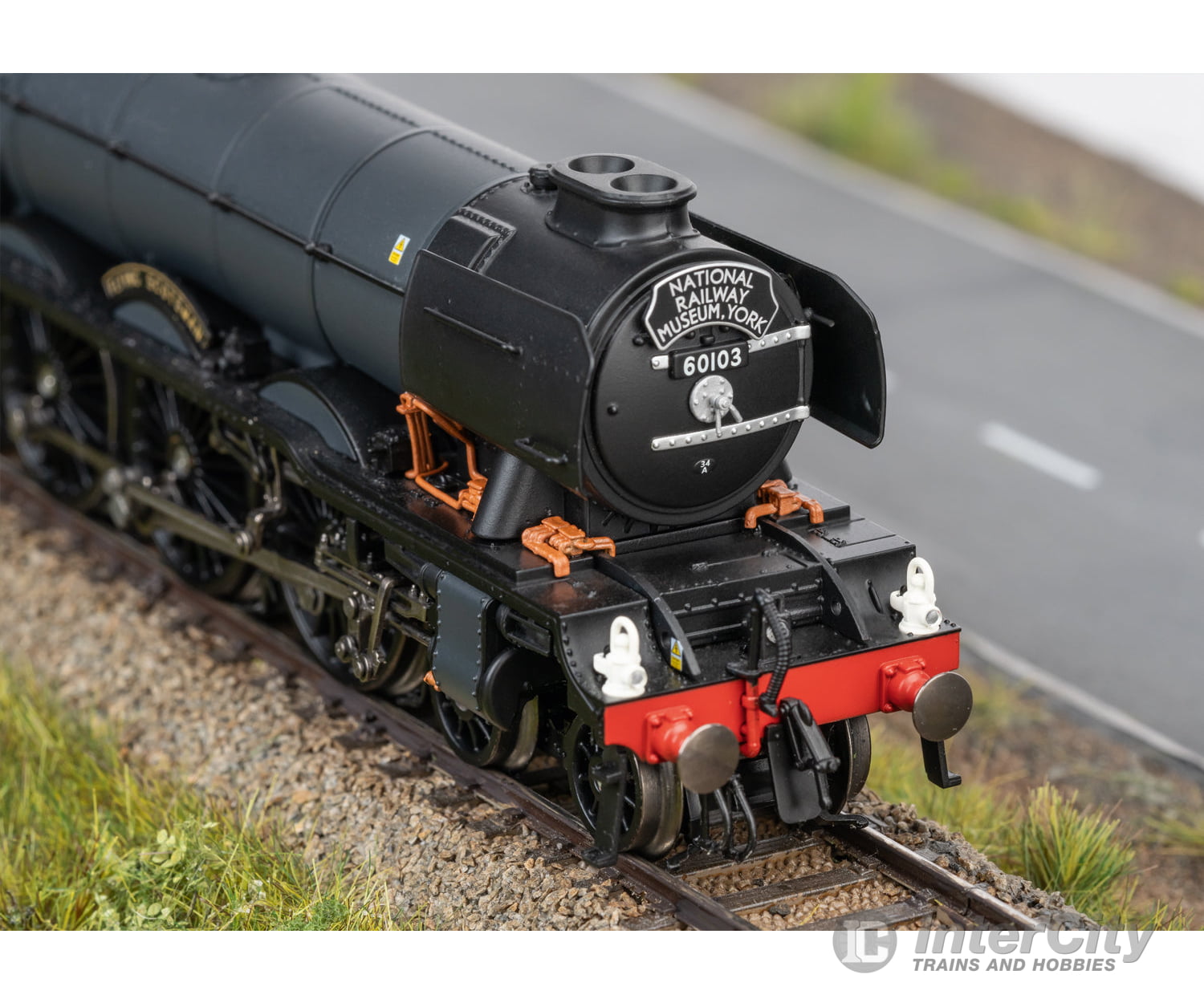Description
Flying Scotsman in Black
World famous, fast, powerful, and a real legend: The steam locomotive with the evocative name "Flying Scotsman" set a number of world records, writing railway history in the process. For decades it pulled the British express train of the same name, which in 1928 raced non-stop from Edinburgh to London and back. It was the first steam locomotive to reach an authenticated speed of 100 mph (160kph) in 1934, and it even later toured through the USA and Australia. In 2023, for the 100th anniversary of this three-cylinder power locomotive, Märklin launched a new model reflecting Flying Scotsman as it is today, with its renowned green livery. Now comes a special exclusive black variant with unique features that reflect a fascinating period in the locomotive's history. Throughout the war, and for several years afterwards, the famous apple green paint scheme made way for a simple black livery, as did many UK locomotives at this time. Towards the end of the general overhaul that took place from 2006, the black colour scheme was chosen again to protect the locomotive during final assembly and testing. During this period young and old had the opportunity to enjoy Flying Scotsman in this unique condition, firstly in 2011 and then again at ‘Railfest 2012', a major rail festival scheduled to coincide with the London Olympics and 800th anniversary of the city of York. The locomotive's final appearance in this temporary black livery was during testing and trial runs in January/February of 2016. Following this, Flying Scotsman was repainted in British Railways green livery and, operating under the number 60103, was back to delight railway fans around the country. In the excellent new Märklin model, this unique version of Flying Scotsman lives on in small scale, another chapter in the life of this fascinating European steam giant.
Prototype: Class A3 steam express locomotive with a tender. Version is represented in postwar black, featuring the two numbers it carried in 1946 - 502 and 103 - as well as its current one on the smokebox door. The locomotive looks as it did at the beginning of 2015 with a corridor tender and smoke deflectors. Locomotive of the National Railway Museum in York, England.
Highlights
- Especially intricate metal construction.
- Many separately applied details.
- Factory-installed smoke unit with speed-dependent, dynamic smoke exhaust.
- Cab and tender corridor lighting digitally controlled.
- Prototypically lettered with three road numbers.
- "World of Operation" mfx+ decoder and extensive light and sound functions included.
- Buffer height on the locomotive and tender adheres to the NEM.
Model: The locomotive has an mfx+ digital decoder and extensive light and sound functions. It also has controlled, high-efficiency propulsion with a flywheel in the boiler. 3 axles powered. Traction tires. The locomotive and tender are constructed mostly of metal. The locomotive has a factory-installed smoke unit with speed-dependent, dynamic smoke exhaust and it can be controlled digitally. Dual headlights on the locomotive change over with the direction of travel and there is a lamp on the back of the tender. These lights will work in conventional operation and can be controlled digitally. The lamp on the back of the tender can be changed to a red lamp. A third headlight on the front of the locomotive can be controlled separately as an electric lamp and it can be changed to red. The cab lighting and firebox flickering can be controlled digitally. The lighting on the tender corridor can be controlled digitally. Maintenance-free warm white and red LEDs are used for the lighting. There is an adjustable close coupling with a guide mechanism between the locomotive and tender. The back of the tender has a close coupler with an NEM pocket and a guide mechanism. The buffer height on the locomotive and tender adheres to the NEM. Brake hoses, imitation prototype couplers, and closed cylinder covers are included. Length over the buffers approximately 24.5 cm / 9-5/8".
| ControlUnit | MobileStation | MobileStation 2 | CentralStation 1/2 | CentralStation 3/2* Mobile Station 2** | |
|---|---|---|---|---|---|
| Headlight(s) | * | * | * | * | * |
| Smoke generator | * | * | * | * | * |
| Steam locomotive op. sounds | * | * | * | * | * |
| Locomotive whistle | * | * | * | * | * |
| Direct control | * | * | * | * | * |
| Sound of squealing brakes off | * | * | * | * | |
| Light Function | * | * | * | * | |
| Flickering Light in Fire Box | * | * | * | * | |
| Headlight(s) | * | * | * | * | |
| Light Function | * | * | * | ||
| Light Function | * | * | * | ||
| Engineer's cab lighting | * | * | * | ||
| Whistle for switching maneuver | * | * | * | ||
| Switching maneuver | * | * | * | ||
| Interior lighting for the corridor | * | * | * | ||
| Letting off Steam | * | * | * | ||
| Coal being shoveled and firebox flickering | * | ||||
| Water Pump | * | ||||
| Injectors | * | ||||
| Replenishing water | * | ||||
| Replenishing coal | * | ||||
| Replenishing sand | * | ||||
| Air Pump | * | ||||
| Stat. Announce. - Engl. | * | ||||
| Stat. Announce. - Engl. | * | ||||
| Announcement: history of the locomotive | * | ||||
| Announcement: history of the locomotive | * | ||||
| Opening cab door | * |






